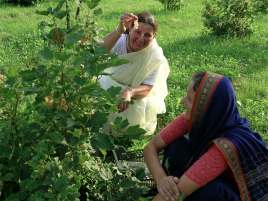Krishna Valley Featured at Budapest Tourism and Travel Expo
By Madhava Smullen | Mar 20, 2011

Devotees from ISKCON Hungary’s Krishna Valley presented their rural community’s activities at Budapest’s annual Tourism and Travel Expo this year, in an effort to further promote the already very popular tourist attraction.
30,000 people visited the Expo, which featured exhibitions by more than 500 companies, over the course of one week from March 8th to March 13th. Many of the visitors were representatives of tourism offices or hotels who were searching for new, interesting places to direct their customers to.
People were welcomed cordially into ISKCON’s 130-square-foot booth by devotees smartly dressed in traditional Vaishnava garb. The aroma of incense wafted through the air, while the chanting of the Hare Krishna maha mantra played softly in the background. The space was well-decorated with flowers and Indian cloth tapestries, as well as an array of colorful photos, posters and pamphlets depicting the activities of the 660-acre sustainable Krishna Valley farm.
“Visitors saw little glimpses of our temple, restaurant, gift shop, cow protection goshala, gurukula school, and botanic gardens,” says Krishna Valley head of tourism Sripati Dasa. “We also gave a presentation on our annual open day fair, and showed examples of the group tours we offer.”
Many people made group reservations to visit the farm on the spot, while others took some of the 19,000 glossy, professional pamphlets distributed. 16,000 contained general tourism information about Krishna Valley, also known as New Vraja Dhama, while the other 3,000 were about the annual Krishna Valley Fair, which will be held from July 22nd to 24th this year.
“We also automatically entered families who answered our questionnaires into a contest to win free entrance to the farm,” says Sripati Dasa. “Forty-five lucky families won the prize!”
Tourist groups who visit Krishna Valley—generally paying an entrance fee that supports the temple—are given the full cultural experience. They are first given a tour of the temple, along with an explanation of the basic tenets of Krishna conscious philosophy. Next, they visit the temple room itself, where they pay their respects to the Deities and have a short bhajan. They then listen to a talk on Srila Prabhupada, the Deities, and reincarnation, before taking part in more chanting. Many launch themselves into the experience with enthusiasm.
“We often have groups of fifty or sixty senior citizens who visit the farm,” Sripati says. “They all gather into the temple room, and during the bhajan, we distribute musical instruments such as kartalas. Within fifteen minutes, they are dancing and chanting joyfully! They love it. And these are people who have never heard anything about Krishna consciousness before.”
Finally, the tourists are served a full vegetarian prasadam meal.
Hungarian devotees are currently working on developing a similar program at the temple in Budapest, their capital.
“Since the Tourism and Travel Expo is in Budapest, it would be the perfect place to advertise a Budapest temple tour,” says Sripati.
Devotees will be delighted if Budapest manages to follow on the heels of Krishna Valley, which draws an astonishing 30,000 tourists annually.
“When we started up, we were just a small little project, but people dropped by because they had heard about an Indian cultural center being established in a rural area, and were fascinated,” Sripati says. “We advertised it, and gradually more and more people came, until we had to set up a tourism department!”
Not ones to keep a good secret to themselves, Krishna Valley devotees will be sharing their knowledge and experience with others—mainly ISKCON devotees—at a meeting in early July this year. The meeting is expected to be an educational initiative supported by EU funds.
“I feel strongly that any ISKCON farm project, even a small one, advertised the right way can attract a lot of tourists,” Sripati concludes. “Because these days, the whole idea of living close to nature is getting more and more popular.”















